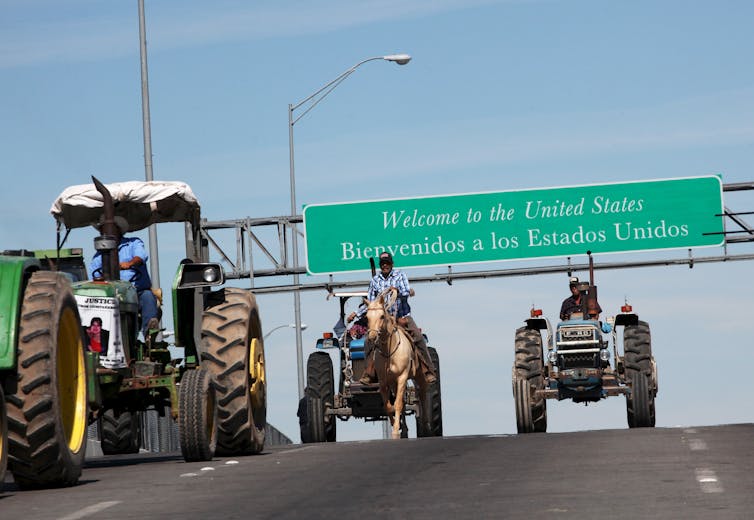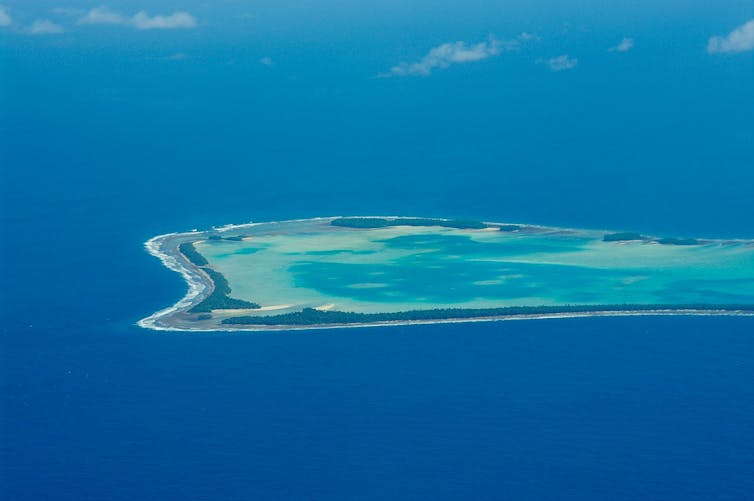Who is responsible for migrants?
- Written by Felipe A. Filomeno, Assistant Professor of Political Science and Global Studies, University of Maryland, Baltimore County
President Donald Trump tends to portray migrants as a foreign problem[1] that has suddenly – and unfairly – been “dumped[2]” at America’s doorstep.
Migration “is a way they get certain people out of their country and dump in U.S.,” he wrote on Nov. 25 about a caravan of mostly Honduran women, children and young men[3] seeking asylum in the United States.
He is not alone. The flow of refugees and asylum-seekers from poor countries to the United States border is often attributed, incorrectly, to domestic unrest in a far-off nation. Some Americans blame far-off governments for not being “willing to take care of their own country’s problems,” as one New York Times reader commenting on the migrant caravan[4] put it recently.
This one-sided view of migration ignores the global forces that bind our world together, my research on immigration policy[5] shows.
The extreme violence, environmental disasters and grinding poverty that drive people from places like Guatemala[6], Honduras[7] and Afghanistan[8] are largely the result of global phenomena like colonialism, climate change[9] and trade.
Seen through an international lens, both migrant-sending and migrant-receiving countries share responsibility for the people displaced by globalization.
Colonialism and its consequences
It’s no coincidence that immigration routes today follow the same path European colonizers did – but in reverse.
France invaded Algeria in 1830 and kept it as a colony until 1962. Today, the largest immigrant group in France[10] is Algerians.
And while Britain today may wish to close its borders, in 1948 it invited citizens of former British colonies into the country[11] to help the United Kingdom rebuild after World War II. Indians and Pakistanis are now the second- and third-largest immigrant groups in the United Kingdom[12], after Polish people.
The Central Americans looking to the United States for refuge are following a similar historical pattern.
Technically, the United States was never an empire. But its government consistently intervened in Latin American domestic affairs[13] during the late 20th century, installing and even removing leaders across the region.
In the 1980s, hoping to beat back Communism, the U.S. funded and armed authoritarian regimes in Central America as they battled leftist guerrillas. These decadeslong civil wars killed thousands and displaced hundreds of thousands.
War also killed the region’s economy. Average income in El Salvador, Guatemala, Honduras and Nicaragua was actually lower in 1990 than it had been in 1980[14].
Regional instability caused mass migration to the United States. Between 1981 and 1990 almost 1 million Salvadorans and Guatemalans entered the United States[15] clandestinely.
Trade, poverty and cheap immigrant labor
Economic links between richer and poorer countries have also spurred mass migration.
More international trade in recent decades has brought jobs and improved living standards in some countries – among them Chile, China and South Korea – preventing migration by creating the economic conditions that allow people to stay put.
Strategic agricultural aid to developing countries, too, has reduced emigration from some rural countries, according to a recent study in the journal World Development[16], which analyzed data from 103 countries that received aid from 1995 to 2010.
But international commerce has also unleashed migration elsewhere.
 Mexican farmers protesting what they say are the unfair working conditions of NAFTA block the U.S.-Mexico border crossing in November 2015.
Reuters/Jose Luis Gonzalez[17]
Mexican farmers protesting what they say are the unfair working conditions of NAFTA block the U.S.-Mexico border crossing in November 2015.
Reuters/Jose Luis Gonzalez[17]
Mexican immigration to the U.S. surged after the North American Free Trade Agreement went into effect in 1994. The deal increased Mexico’s manufacturing sector substantially[18] – but it hurt farmers by opening Mexican markets to subsidized U.S. agricultural products[19].
Unable to compete with these cheap imports, hundreds of thousands of Mexican farmers lost their jobs. By 2006, an estimated 2 million peasants had been pushed out of rural areas[20] in Mexico. Many of these displaced farmers migrated to the U.S.[21], where they found jobs in the construction, agricultural and restaurant sectors.
Today, Hispanics make up around a quarter of workers in those industries[22]. The same low-wage immigrant labor helps to keep manufacturing afloat in the U.S.[23] despite the otherwise high costs of doing business.
Trump insists[24] only that cheap imports from developing countries threatens U.S. industry. The realities of migration are more complex and nuanced than that.
Climate refugees
Climate change is another global problem contributing to the migration crisis[25].
Global warming-related problems like rising sea levels and extreme weather have their origins in the Industrial Revolution in Europe 150 years ago. But their impacts are hitting poor countries first and hardest[26].
Residents of small Pacific islands such as Kiribati and Tuvalu[27] must abandon their homes because coastal erosion is pushing people inland, creating conflicts over the scarce remaining dry land[28].
 Tuvalu is among the low-lying island nations facing imminent risk of extinction.
Tomoaki INABA, CC BY-SA[29][30]
Tuvalu is among the low-lying island nations facing imminent risk of extinction.
Tomoaki INABA, CC BY-SA[29][30]
Even Central American migration is linked in part to climate change[31]. Changes in temperature and rainfall across the region have damaged the coffee and maize crops over the past decade. Some farmers who’ve lost their rural livelihood joined the caravan earlier this year.
And though China[32] has surpassed the United States as the world’s largest emitter of greenhouse gases, people in rich countries still use a disproportionate share of global resources.
Per capita carbon emissions in high-income countries is about 30 times higher than in low-income countries[33] because people in the richer countries have bigger and more air-conditioned homes, eat more meat and drive and fly more[34].
Such statistics raise serious doubt about who, exactly, should take responsibility for modern climate refugees.
Stopping migration before it starts
Rich countries are not to blame for every problem that drives migration from poor countries.
Corrupt, predatory and violent leaders in Central America[35], Syria, Pakistan and many other places are also accountable for creating hazardous conditions in their countries.
And Haiti’s devastating 2010 earthquake, which destroyed the nation’s capital and sent thousands fleeing for their lives[36], had nothing to do with climate change.
Still, too much political rhetoric out of Washington offers a simplistic, one-sided view of migration. A more balanced debate might help policymakers take measures that might actually address the problem, rather than just casting blame on poor countries and closing borders.
Other countries increasingly agree. On Dec. 10, 164 nations signed the Global Compact for Migration[37], the world’s first-ever comprehensive international agreement. It assigns shared responsibility for hosting migrants in ensuring their human rights are respected and addressing the root causes of displacement.
The United States was not one of them.
References
- ^ foreign problem (twitter.com)
- ^ dumped (twitter.com)
- ^ caravan of mostly Honduran women, children and young men (theconversation.com)
- ^ the migrant caravan (www.facebook.com)
- ^ research on immigration policy (www.palgrave.com)
- ^ Guatemala (theconversation.com)
- ^ Honduras (theconversation.com)
- ^ Afghanistan (theconversation.com)
- ^ climate change (theconversation.com)
- ^ largest immigrant group in France (www.telegraph.co.uk)
- ^ citizens of former British colonies into the country (www.bl.uk)
- ^ second- and third-largest immigrant groups in the United Kingdom (migrationobservatory.ox.ac.uk)
- ^ consistently intervened in Latin American domestic affairs (www.wiley.com)
- ^ lower in 1990 than it had been in 1980 (data.worldbank.org)
- ^ almost 1 million Salvadorans and Guatemalans entered the United States (www.migrationpolicy.org)
- ^ recent study in the journal World Development (www.sciencedirect.com)
- ^ Reuters/Jose Luis Gonzalez (pictures.reuters.com)
- ^ increased Mexico’s manufacturing sector substantially (theconversation.com)
- ^ opening Mexican markets to subsidized U.S. agricultural products (carnegieendowment.org)
- ^ an estimated 2 million peasants had been pushed out of rural areas (www.cbsnews.com)
- ^ migrated to the U.S. (www.jstor.org)
- ^ quarter of workers in those industries (www.bls.gov)
- ^ keep manufacturing afloat in the U.S. (www.jstor.org)
- ^ insists (theconversation.com)
- ^ contributing to the migration crisis (www.sciencedirect.com)
- ^ hitting poor countries first and hardest (theconversation.com)
- ^ small Pacific islands such as Kiribati and Tuvalu (books.google.com)
- ^ scarce remaining dry land (www.theguardian.com)
- ^ Tomoaki INABA (www.flickr.com)
- ^ CC BY-SA (creativecommons.org)
- ^ climate change (www.theguardian.com)
- ^ China (data.worldbank.org)
- ^ 30 times higher than in low-income countries (data.worldbank.org)
- ^ drive and fly more (journals.sagepub.com)
- ^ in Central America (theconversation.com)
- ^ sent thousands fleeing for their lives (www.fmreview.org)
- ^ Global Compact for Migration (undocs.org)
Authors: Felipe A. Filomeno, Assistant Professor of Political Science and Global Studies, University of Maryland, Baltimore County
Read more http://theconversation.com/who-is-responsible-for-migrants-108388


